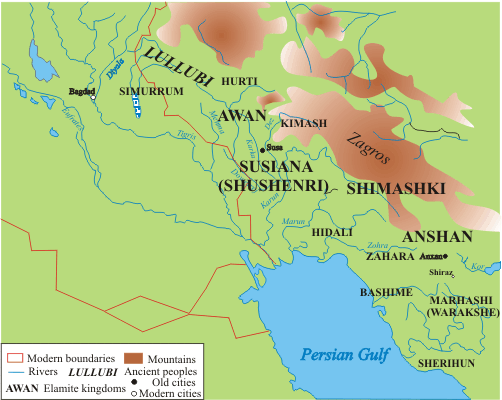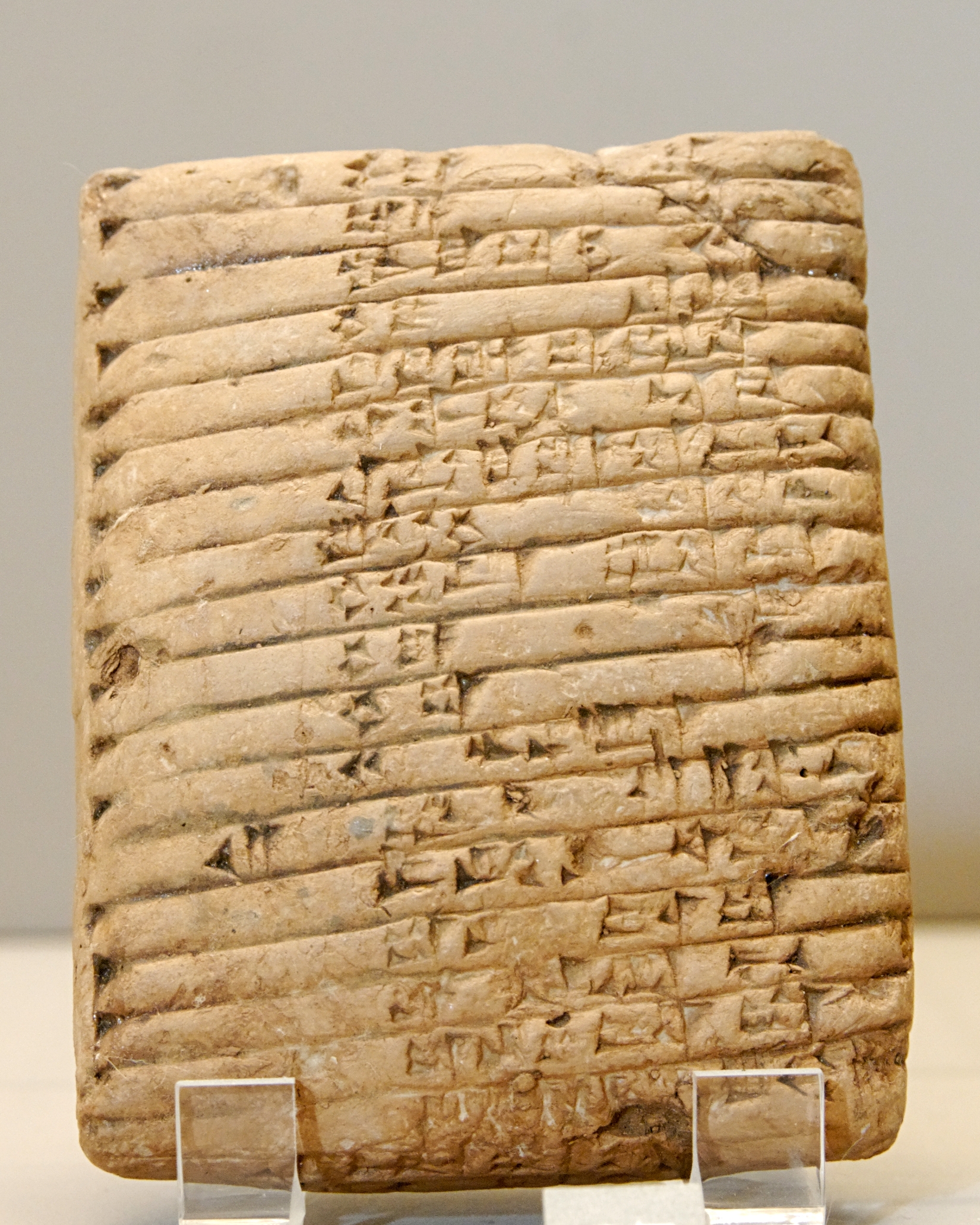Shimashki Dynasty on:
[Wikipedia]
[Google]
[Amazon]


 The Shimashki or Simashki dynasty (, ''lugal-ene si-mash-giki'' "Kings of the country of Simashgi"), was an early dynasty of the ancient region of
The Shimashki or Simashki dynasty (, ''lugal-ene si-mash-giki'' "Kings of the country of Simashgi"), was an early dynasty of the ancient region of
 Kindattu was also known as Kindadu. A Kindattu, who according to Daryaeee was "apparently" the Shimashkian king of the list above, lead the army that destroyed the Third Dynasty of Ur in 2004 BCE. The operation was a joint effort between Kindattu and his then-ally
Kindattu was also known as Kindadu. A Kindattu, who according to Daryaeee was "apparently" the Shimashkian king of the list above, lead the army that destroyed the Third Dynasty of Ur in 2004 BCE. The operation was a joint effort between Kindattu and his then-ally


 The Shimashki or Simashki dynasty (, ''lugal-ene si-mash-giki'' "Kings of the country of Simashgi"), was an early dynasty of the ancient region of
The Shimashki or Simashki dynasty (, ''lugal-ene si-mash-giki'' "Kings of the country of Simashgi"), was an early dynasty of the ancient region of Elam
Elam (; Linear Elamite: ''hatamti''; Cuneiform Elamite: ; Sumerian: ; Akkadian: ; he, עֵילָם ''ʿēlām''; peo, 𐎢𐎺𐎩 ''hūja'') was an ancient civilization centered in the far west and southwest of modern-day Iran, stretc ...
, to the southeast of Babylonia, in approximately 2100-1900 BCE. A list of twelve kings of Shimashki is found in the Elamite king-list of Susa, which also contains a list of kings of Awan dynasty
The Awan Dynasty ( Sumerian: ''lugal-e-ne a-wa-anki'', "Kings of Awan") was the first dynasty of Elam of which very little of anything is known today, appearing at the dawn of historical record. The Dynasty corresponds to the early part of the Ol ...
. It is uncertain how historically accurate the list is (and whether it reflects a chronological order), although some of its kings can be corroborated by their appearance in the records of neighboring peoples. The Dynasty corresponds to the middle part of the Old Elamite period
Elam (; Linear Elamite: ''hatamti''; Cuneiform Elamite: ; Sumerian: ; Akkadian: ; he, עֵילָם ''ʿēlām''; peo, 𐎢𐎺𐎩 ''hūja'') was an ancient civilization centered in the far west and southwest of modern-day Iran, stret ...
(dated c.2700 – c. 1600 BC). It was followed by the Sukkalmah Dynasty
The Sukkalmah Dynasty (c. 1900-1500 BCE), also Epartid Dynasty after the founder Eparti/Ebarat, was an early dynasty of West Asia in the ancient region of Elam, to the southeast of Babylonia. It corresponds to the latest part of the Old Elamite pe ...
. Shimashki was likely near today's Masjed Soleyman
Masjed Soleyman ( fa, مسجدسلیمان, also Romanized as Masjedsoleimān, Masjed-e Soleymān, Masjed Soleiman, and Masjid-i-Sulaiman) is a city and capital of Masjed Soleyman County, Khuzestan Province, Iran. At the 2006 census, its populat ...
.
Nature of the "Dynasty"
Daryaee suggests that, despite the impression from the king-list that the rulers of Shimashki was a dynasty of sequential rulers, it is perhaps better to think of Shimashki as an alliance of various peoples "rather than a unitary state."Occupation of Mesopotamia
The Shimashki confederacy led an alliance against theUr III
The Third Dynasty of Ur, also called the Neo-Sumerian Empire, refers to a 22nd to 21st century BC ( middle chronology) Sumerian ruling dynasty based in the city of Ur and a short-lived territorial-political state which some historians consider t ...
Empire, and managed to defeat its last ruler Ibbi-Sin
Ibbi-Sin ( sux, , ), son of Shu-Sin, was king of Sumer and Akkad and last king of the Ur III dynasty, and reigned c. 2028–2004 BCE ( Middle chronology) or possibly c. 1964–1940 BCE (Short chronology). During his rei ...
. After this victory, they destroyed the kingdom, looted the capital of Ur, and ruled through military occupation for the next 21 years.
The Shimashki rulers became participants in an ongoing conflict with the rulers of Isin
Isin (, modern Arabic: Ishan al-Bahriyat) is an archaeological site in Al-Qādisiyyah Governorate, Iraq. Excavations have shown that it was an important city-state in the past.
History of archaeological research
Ishan al-Bahriyat was visited b ...
and Larsa
Larsa ( Sumerian logogram: UD.UNUGKI, read ''Larsamki''), also referred to as Larancha/Laranchon (Gk. Λαραγχων) by Berossos and connected with the biblical Ellasar, was an important city-state of ancient Sumer, the center of the cul ...
after the fall of Third Dynasty of Ur
The Third Dynasty of Ur, also called the Neo-Sumerian Empire, refers to a 22nd to 21st century Common Era, BC (middle chronology) Sumerian ruling dynasty based in the city of Ur and a short-lived territorial-political state which some historians c ...
.
Under the Shimashki and their successors the Sukkalmah, Elam then became one of the most powerful kingdoms of West Asia, influencing the territories of Mesopotamia and Syria through commercial, military or diplomatic contacts. Expansion in Mesopotamia was only halted by the Babylonian king Hammurabi
Hammurabi (Akkadian: ; ) was the sixth Amorite king of the Old Babylonian Empire, reigning from to BC. He was preceded by his father, Sin-Muballit, who abdicated due to failing health. During his reign, he conquered Elam and the city-states ...
in the 18th century BC. After a prolonged conflict, the military forces of Elam were finally forced to retreat their forces positioned along the Tigris river
The Tigris () is the easternmost of the two great rivers that define Mesopotamia, the other being the Euphrates. The river flows south from the mountains of the Armenian Highlands through the Syrian and Arabian Deserts, and empties into the P ...
, and to return to Susa
Susa ( ; Middle elx, 𒀸𒋗𒊺𒂗, translit=Šušen; Middle and Neo- elx, 𒋢𒋢𒌦, translit=Šušun; Neo-Elamite and Achaemenid elx, 𒀸𒋗𒐼𒀭, translit=Šušán; Achaemenid elx, 𒀸𒋗𒐼, translit=Šušá; fa, شوش ...
.
Paleography
Shimashki is first mentioned on the inscription to an image ofPuzur-Inshushinak
Puzur-Inshushinak (Linear Elamite: ''Puzur Šušinak'', Akkadian: , ''puzur3- dinšušinak'', also , ''puzur4- dinšušinak'' "Calling Inshushinak"), also sometimes thought to read Kutik-Inshushinak in Elamite, was king of Elam, around 2100 BC, ...
, king of Awan around 2100 BC, which depicts a Shimashkian king as subordinate to him.
The Shimashki dynasty was followed by the Sukkalmah dynasty
The Sukkalmah Dynasty (c. 1900-1500 BCE), also Epartid Dynasty after the founder Eparti/Ebarat, was an early dynasty of West Asia in the ancient region of Elam, to the southeast of Babylonia. It corresponds to the latest part of the Old Elamite pe ...
(c. 1900-1500).
Individual Rulers
The names in the king-list, as found in Potts, are "Girnamme, Tazitta, Ebarti, Tazitta, Lu -x-xlu-uh-ha-an, Kindattu, Idaddu, Tan-Ruhurater, Ebarti, Idaddu, Idaddu-napir, Idaddu-temti, twelve Sumerian kings" (bracketed letters original). Girnamme ruled at the same time asShu-Sin
Shu-Sin, also Šu-Suen ( akk, : '' DŠu D Sîn'', after the Moon God Sîn", the "𒀭" being a silent honorific for "Divine", formerly read Gimil-Sin) was king of Sumer and Akkad, and was the penultimate king of the Ur III dynasty. He succeeded ...
, king of Ur, and was involved, as either a groom or simply a facilitator, in the marriage of Shu-Sin's daughter. Gwendolyn Leick places this event in 2037 BCE. Girnamme, along with Tazitta and Ebarti I, appears in "Mesopotamian texts establishing food rations issued to messengers," texts from 2044-2032 BCE.
Tazitta, the second figure in the list, is referred to in a document from the eighth year of the reign of Amar-Sin
Amar-Sin ( akk, : '' DAmar D Sîn'', after the Moon God Sîn", the "𒀭" being a silent honorific for "Divine"), initially misread as Bur-Sin (c. 2046-2037 BC middle chronology, or possibly ca. 1982–1973 BC short chronology) was the third rule ...
of Ur.
 Kindattu was also known as Kindadu. A Kindattu, who according to Daryaeee was "apparently" the Shimashkian king of the list above, lead the army that destroyed the Third Dynasty of Ur in 2004 BCE. The operation was a joint effort between Kindattu and his then-ally
Kindattu was also known as Kindadu. A Kindattu, who according to Daryaeee was "apparently" the Shimashkian king of the list above, lead the army that destroyed the Third Dynasty of Ur in 2004 BCE. The operation was a joint effort between Kindattu and his then-ally Ishbi-Erra
Ishbi-Erra ( Akkadian: d''iš-bi-ir₃-ra'') was the founder of the dynasty of Isin, reigning from ''c.'' 2017 — ''c.'' 1986 BC on the middle chronology or 1953 BC — ''c.'' 1920 BC on the short chronology. Ishbi-Erra was preceded by Ibbi-Si ...
, who defeated Ur and captured Ibbi-Sin
Ibbi-Sin ( sux, , ), son of Shu-Sin, was king of Sumer and Akkad and last king of the Ur III dynasty, and reigned c. 2028–2004 BCE ( Middle chronology) or possibly c. 1964–1940 BCE (Short chronology). During his rei ...
, its king. The Ishbi-Erra hymn claims that Ishbi-Erra
Ishbi-Erra ( Akkadian: d''iš-bi-ir₃-ra'') was the founder of the dynasty of Isin, reigning from ''c.'' 2017 — ''c.'' 1986 BC on the middle chronology or 1953 BC — ''c.'' 1920 BC on the short chronology. Ishbi-Erra was preceded by Ibbi-Si ...
later expelled Kindattu from Mesopotamia.
Idaddu I (also known as Indattu-Inshushinak, or simply Indattu) called himself "king of Shimashki and Elam". According to Stolper and André-Salvini, he was the son of Kindattu, while Gwendolyn Leick calls him "son of Pepi," claiming that Kindattu may have been his grandfather. According to Leick he ascended to the throne of Shimashki around 1970 BCE.
Tan-Ruhurater, also known as Tan-Ruhuratir, formed an alliance with Bilalama, the governor of Eshnunna, by marrying Bilama's daughter Mê-Kubi.On the alliance, see On Bilalama's position as governor of Eshnunna, see
Ebarti II of Shimashki may have been the same individual known as Ebarat, a '' Sukkalmah'', or "Grand Regent". If so, he was ruler simultaneously to the next member of the list of twelve Shimaskin kings: Idaddu II.
Idaddu II was the son of Tan-Ruhurater, during whose reign he oversaw building projects as the governor of Susa. According to Leick, he was the last of the Shimashkian kings.
Rulers
See also
*Awan dynasty
The Awan Dynasty ( Sumerian: ''lugal-e-ne a-wa-anki'', "Kings of Awan") was the first dynasty of Elam of which very little of anything is known today, appearing at the dawn of historical record. The Dynasty corresponds to the early part of the Ol ...
*List of rulers of Elam
The kings of Elam were the rulers of Elam, an ancient civilization in modern-day south-western Iran. The earliest known Elamite dynasty was the Awan dynasty, which came to power in the Early Dynastic period. Elam was conquered by the Akkadian E ...
References
{{reflistSources
* Hinz, W., "The Lost World of Elam", London, 1972 (tr. F. Firuznia, دنیای گمشده ایلام, Tehran, 1992) * Potts, D. T., The Archaeology of Elam, Cambridge University Press, 1999. Elamite kings Shimashki Dynasty